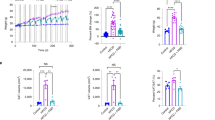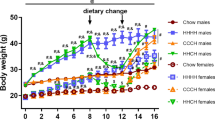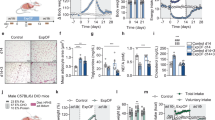Abstract
Background:
Combatting overweight or obesity can lead to large fluctuations in an individual’s body weight, often referred to as weight cycling or ‘yo-yo’ dieting. Current evidence regarding the potentially damaging effects of these changes is conflicting.
Methods:
Here, we assess the metabolic effects of weight cycling in a murine model, comprising three dietary switches to normal or high-fat diets at 6 week intervals; male C57BL/6 mice were fed either a control (C) or high-fat (F) diet for 6 weeks (n=140/group). C and F groups were then either maintained on their initial diet (CC and FF, respectively) or switched to a high-fat (CF) or control (FC) diet (n=35/group). For the final 6 week interval, CC and CF groups were returned to the control diet (CCC and CFC groups), while FC and FF groups were placed on a high-fat diet (FCF and FFF) (n=28/group).
Results:
For the majority of metabolic outcomes changes aligned with dietary switches; however, assessment of neuropeptides and receptors involved in appetite regulation and reward signalling pathways reveal variable patterns of expression. Furthermore, we demonstrate that multiple cycling events leads to a significant increase in internal fat deposition, even when compared with animals maintained on a high-fat diet (internal fat: FCF: 7.4±0.2 g vs FFF: 5.6±0.2 g; P<0.01).
Conclusions:
Increased internal adipose tissue is strongly linked to the development of metabolic syndrome associated conditions such as type 2 diabetes, cardiovascular disease and hypertension. Although further work will be required to elucidate the mechanisms underlying the neuronal control of energy homoeostasis, these studies provide a causative link between weight cycling and adverse health.
This is a preview of subscription content, access via your institution
Access options
Subscribe to this journal
Receive 12 print issues and online access
$259.00 per year
only $21.58 per issue
Buy this article
- Purchase on Springer Link
- Instant access to full article PDF
Prices may be subject to local taxes which are calculated during checkout





Similar content being viewed by others
References
Adan RA . Mechanisms underlying current and future anti-obesity drugs. Trends Neurosci 2013; 36: 133–140.
Kraschnewski JL, Boan J, Esposito J, Sherwood NE, Lehman EB, Kephart DK et al. Long-term weight loss maintenance in the United States. Int J Obes 2010; 34: 1644–1654.
Graci S, Izzo G, Savino S, Cattani L, Lezzi G, Berselli ME et al. Weight cycling and cardiovascular risk factors in obesity. Int J Obes Relat Metab Disord 2004; 28: 65–71.
Field AE, Manson JE, Laird N, Williamson DF, Willett WC, Colditz GA . Weight cycling and the risk of developing type 2 diabetes among adult women in the United States. Obes Res 2004; 12: 267–274.
Lien LF, Haqq AM, Arlotto M, Slentz CA, Muehlbauer MJ, McMahon RL et al. The STEDMAN project: biophysical, biochemical and metabolic effects of a behavioral weight loss intervention during weight loss, maintenance, and regain. OMICS 2009; 13: 21–35.
Mason C, Foster-Schubert KE, Imayama I, Xiao L, Kong A, Campbell KL et al. History of weight cycling does not impede future weight loss or metabolic improvements in postmenopausal women. Metabolism 2013; 62: 127–136.
Stevens VL, Jacobs EJ, Sun J, Patel AV, McCullough ML, Teras LR et al. Weight cycling and mortality in a large prospective US study. Am J Epidemiol 2012; 175: 785–792.
Wallner SJ, Luschnigg N, Schnedl WJ, Lahousen T, Sudi K, Crailsheim K et al. Body fat distribution of overweight females with a history of weight cycling. Int J Obes Relat Metab Disord 2004; 28: 1143–1148.
Zhang H, Tamakoshi K, Yatsuya H, Murata C, Wada K, Otsuka R et al. Long-term body weight fluctuation is associated with metabolic syndrome independent of current body mass index among Japanese men. Circ J 2005; 69: 13–18.
Montani JP, Viecelli AK, Prevot A, Dulloo AG . Weight cycling during growth and beyond as a risk factor for later cardiovascular diseases: the 'repeated overshoot' theory. Int J Obes 2006; 30: S58–S66.
Vergnaud AC, Bertrais S, Oppert JM, Maillard-Teyssier L, Galan P, Hercberg S et al. Weight fluctuations and risk for metabolic syndrome in an adult cohort. Int J Obes 2008; 32: 315–321.
Savage JS, Birch LL . Patterns of weight control strategies predict differences in women's 4-year weight gain. Obesity 2010; 18: 513–520.
Lu H, Buison A, Uhley V, Jen KL . Long-term weight cycling in female Wistar rats: effects on metabolism. Obes Res 1995; 3: 521–530.
Ernsberger P, Koletsky RJ, Baskin JS, Collins LA . Consequences of weight cycling in obese spontaneously hypertensive rats. Am J Physiol 1996; 270: R864–R872.
Lim K, Murakami E, Lee S, Shimomura Y, Suzuki M . Effects of intermittent food restriction and refeeding on energy efficiency and body fat deposition in sedentary and exercised rats. J Nutr Sci Vitaminol 1996; 42: 449–468.
Graham B, Chang S, Lin D, Yakubu F, Hill JO . Effect of weight cycling on susceptibility to dietary obesity. Am J Physiol 1990; 259: R1096–R1102.
Lauer JB, Reed GW, Hill JO . Effects of weight cycling induced by diet cycling in rats differing in susceptibility to dietary obesity. Obes Res 1999; 7: 215–222.
Matthews DR, Hosker JP, Rudenski AS, Naylor BA, Treacher DF, Turner RC . Homeostasis model assessment: insulin resistance and beta-cell function from fasting plasma glucose and insulin concentrations in man. Diabetologia 1985; 28: 412–419.
Bettscheider M, Murgatroyd C, Spengler D . Simultaneous DNA and RNA isolation from brain punches for epigenetics. BMC Res Notes 2011; 4: 314.
Franklin KBJ, Paxinos G . The Mouse Brain in Stereotaxic Coordinates. Academic Press, 1997.
Bookout AL, Mangelsdorf DJ . Quantitative real-time PCR protocol for analysis of nuclear receptor signaling pathways. Nucl Recept Signal 2003; 1: e012.
Despres JP, Lemieux I . Abdominal obesity and metabolic syndrome. Nature 2006; 444: 881–887.
Fabbrini E, Magkos F, Mohammed BS, Pietka T, Abumrad NA, Patterson BW et al. Intrahepatic fat, not visceral fat, is linked with metabolic complications of obesity. Proc Natl Acad Sci USA 2009; 106: 15430–15435.
Mehta T, Smith Jr DL, Muhammad J, Casazza K . Impact of weight cycling on risk of morbidity and mortality. Obes Rev 2014; 15: 870–881.
Martin-Gronert MS, Ozanne SE . Early life programming of obesity. Med Wieku Rozwoj 2013; 17: 7–12.
Power ML, Schulkin J . Sex differences in fat storage, fat metabolism, and the health risks from obesity: possible evolutionary origins. Br J Nutr 2008; 99: 931–940.
Asarian L, Geary N . Sex differences in the physiology of eating. Am J Physiol Regul Integr Comp Physiol 2013; 305: R1215–R1267.
Lahti-Koski M, Mannisto S, Pietinen P, Vartiainen E . Prevalence of weight cycling and its relation to health indicators in Finland. Obes Res 2005; 13: 333–341.
List EO, Berryman DE, Wright-Piekarski J, Jara A, Funk K, Kopchick JJ . The effects of weight cycling on lifespan in male C57BL/6J mice. Int J Obes 2013; 37: 1088–1094.
Parekh PI, Petro AE, Tiller JM, Feinglos MN, Surwit RS . Reversal of diet-induced obesity and diabetes in C57BL/6J mice. Metabolism 1998; 47: 1089–1096.
Guo J, Jou W, Gavrilova O, Hall KD . Persistent diet-induced obesity in male C57BL/6 mice resulting from temporary obesigenic diets. PLoS ONE 2009; 4: e5370.
Barbosa-da-Silva S, Fraulob-Aquino JC, Lopes JR, Mandarim-de-Lacerda CA, Aguila MB . Weight cycling enhances adipose tissue inflammatory responses in male mice. PLoS ONE 2012; 7: e39837.
Perseghin G . Lipids in the wrong place: visceral fat and nonalcoholic steatohepatitis. Diabetes Care 2011; 34: S367–S370.
Byrne CD . Dorothy Hodgkin Lecture 2012: non-alcoholic fatty liver disease, insulin resistance and ectopic fat: a new problem in diabetes management. Diabet Med 2012; 29: 1098–1107.
Kursawe R, Eszlinger M, Narayan D, Liu T, Bazuine M, Cali AM et al. Cellularity and adipogenic profile of the abdominal subcutaneous adipose tissue from obese adolescents: association with insulin resistance and hepatic steatosis. Diabetes 2010; 59: 2288–2296.
Carobbio S, Rodriguez-Cuenca S, Vidal-Puig A . Origins of metabolic complications in obesity: ectopic fat accumulation. The importance of the qualitative aspect of lipotoxicity. Curr Opin Clin Nutr Metab Care 2011; 14: 520–526.
Palou M, Sanchez J, Priego T, Rodriguez AM, Pico C, Palou A . Regional differences in the expression of genes involved in lipid metabolism in adipose tissue in response to short- and medium-term fasting and refeeding. J Nutr Biochem 2010; 21: 23–33.
Singh P, Somers VK, Romero-Corral A, Sert-Kuniyoshi FH, Pusalavidyasagar S, Davison DE et al. Effects of weight gain and weight loss on regional fat distribution. Am J Clin Nutr 2012; 96: 229–233.
Bjorndal B, Burri L, Staalesen V, Skorve J, Berge RK . Different adipose depots: their role in the development of metabolic syndrome and mitochondrial response to hypolipidemic agents. J Obes 2011; 2011: 490650.
Byrne NM, Weinsier RL, Hunter GR . Desmond R, Patterson MA, Darnell BE et al. Influence of distribution of lean body mass on resting metabolic rate after weight loss and weight regain: comparison of responses in white and black women. Am J Clin Nutr 2003; 77: 1368–1373.
Lee JS, Visser M, Tylavsky FA, Kritchevsky SB, Schwartz AV, Sahyoun N et al. Weight loss and regain and effects on body composition: the Health, Aging, and Body Composition Study. J Gerontol A Biol Sci Med Sci 2010; 65: 78–83.
Beavers KM, Lyles MF, Davis CC, Wang X, Beavers DP, Nicklas BJ . Is lost lean mass from intentional weight loss recovered during weight regain in postmenopausal women? Am J Clin Nutr 2011; 94: 767–774.
Heitmann BL, Garby L . Composition (lean and fat tissue) of weight changes in adult Danes. Am J Clin Nutr 2002; 75: 840–847.
Bosy-Westphal A, Schautz B, Lagerpusch M, Pourhassan M, Braun W, Goele K et al. Effect of weight loss and regain on adipose tissue distribution, composition of lean mass and resting energy expenditure in young overweight and obese adults. Int J Obes 2013; 37: 1371–1377.
Ziotopoulou M, Mantzoros CS, Hileman SM, Flier JS . Differential expression of hypothalamic neuropeptides in the early phase of diet-induced obesity in mice. Am J Physiol Endocrinol Metab 2000; 279: E838–E845.
Wang H, Storlien LH, Huang XF . Effects of dietary fat types on body fatness, leptin, and ARC leptin receptor, NPY, and AgRP mRNA expression. Am J Physiol Endocrinol Metab 2002; 282: E1352–E1359.
Hansen MJ, Jovanovska V, Morris MJ . Adaptive responses in hypothalamic neuropeptide Y in the face of prolonged high-fat feeding in the rat. J Neurochem 2004; 88: 909–916.
Yu Y, Deng C, Huang XF . Obese reversal by a chronic energy restricted diet leaves an increased Arc NPY/AgRP, but no alteration in POMC/CART, mRNA expression in diet-induced obese mice. Behav Brain Res 2009; 205: 50–56.
Ellacott KL, Halatchev IG, Cone RD . Interactions between gut peptides and the central melanocortin system in the regulation of energy homeostasis. Peptides 2006; 27: 340–349.
Cowley MA, Smart JL, Rubinstein M, Cerdan MG, Diano S, Horvath TL et al. Leptin activates anorexigenic POMC neurons through a neural network in the arcuate nucleus. Nature 2001; 411: 480–484.
Wang GJ, Volkow ND, Logan J, Pappas NR, Wong CT, Zhu W et al. Brain dopamine and obesity. Lancet 2001; 357: 354–357.
Murray S, Tulloch A, Gold MS, Avena NM . Hormonal and neural mechanisms of food reward, eating behaviour and obesity. Nat Rev Endocrinol 2014; 10: 540–552.
Kenny PJ . Reward mechanisms in obesity: new insights and future directions. Neuron 2011; 69: 664–679.
Vucetic Z, Reyes TM . Central dopaminergic circuitry controlling food intake and reward: implications for the regulation of obesity. Wiley Interdiscip Rev Syst Biol Med 2010; 2: 577–593.
Dulloo AG, Jacquet J, Montani JP, Schutz Y . How dieting makes the lean fatter: from a perspective of body composition autoregulation through adipostats and proteinstats awaiting discovery. Obes Rev 2015; 16: 25–35.
Bergman RN, Kim SP, Catalano KJ, Hsu IR, Chiu JD, Kabir M et al. Why visceral fat is bad: mechanisms of the metabolic syndrome. Obesity 2006; 14: 16S–19S.
Acknowledgements
We acknowledge the Medical Research Council for funding and support.
Author information
Authors and Affiliations
Corresponding author
Ethics declarations
Competing interests
The authors declare no conflict of interest.
Additional information
Author Contributions
SES conducted research, analysed and interpreted data; ABH, GJSC and MS conducted research, JRCP interpreted data and wrote paper. JDB designed research and had primary responsibility for final content. All authors contributed to the preparation of the final manuscript.
Supplementary Information accompanies this paper on International Journal of Obesity website
Supplementary information
Rights and permissions
About this article
Cite this article
Schofield, S., Parkinson, J., Henley, A. et al. Metabolic dysfunction following weight cycling in male mice. Int J Obes 41, 402–411 (2017). https://doi.org/10.1038/ijo.2016.193
Received:
Revised:
Accepted:
Published:
Issue Date:
DOI: https://doi.org/10.1038/ijo.2016.193
This article is cited by
-
Weight cycling based on altered immune microenvironment as a result of metaflammation
Nutrition & Metabolism (2023)
-
Diet composition influences the metabolic benefits of short cycles of very low caloric intake
Nature Communications (2021)



